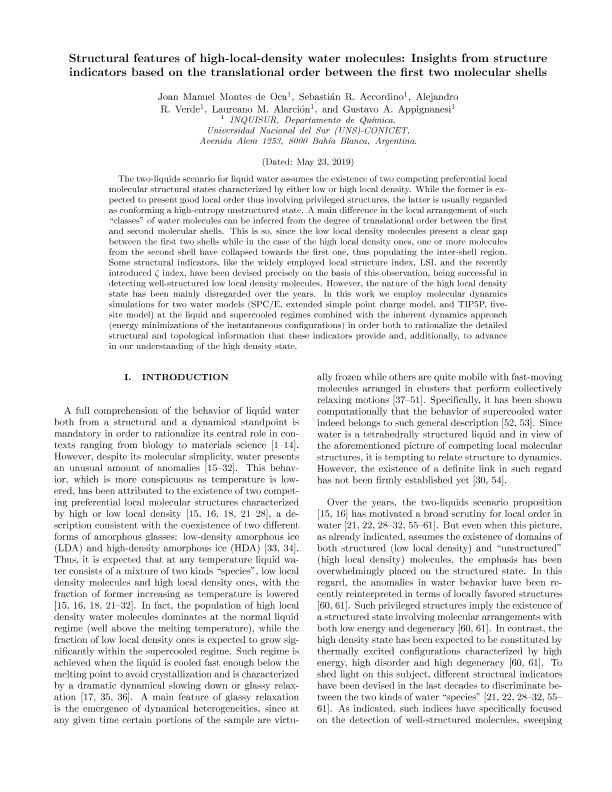Mostrar el registro sencillo del ítem
dc.contributor.author
Montes de Oca, Joan Manuel

dc.contributor.author
Accordino, Sebastián R.
dc.contributor.author
Verde, Alejandro Raúl

dc.contributor.author
Alarcón, Laureano M.
dc.contributor.author
Appignanesi, Gustavo Adrian

dc.date.available
2020-03-13T20:09:35Z
dc.date.issued
2019-06
dc.identifier.citation
Montes de Oca, Joan Manuel; Accordino, Sebastián R.; Verde, Alejandro Raúl; Alarcón, Laureano M.; Appignanesi, Gustavo Adrian; Structural features of high-local-density water molecules: Insights from structure indicators based on the translational order between the first two molecular shells; American Physical Society; Physical Review E; 99; 6; 6-2019; 62601-62613
dc.identifier.issn
2470-0045
dc.identifier.uri
http://hdl.handle.net/11336/99586
dc.description.abstract
The two-liquids scenario for liquid water assumes the existence of two competing preferential local molecular structural states characterized by either low or high local density. While the former is expected to present good local order thus involving privileged structures, the latter is usually regarded as conforming a high-entropy unstructured state. A main difference in the local arrangement of such "classes" of water molecules can be inferred from the degree of translational order between the first and second molecular shells. This is so, since the low-local-density molecules present a clear gap between the first two shells while in the case of the high-local-density ones, one or more molecules from the second shell have collapsed toward the first one, thus populating the intershell region. Some structural indicators, like the widely employed local structure index and the recently introduced ζ index, have been devised precisely on the basis of this observation, being successful in detecting well-structured low-local-density molecules. However, the nature of the high-local-density state has been mainly disregarded over the years. In this work we employ molecular dynamics simulations for two water models (the extended simple point charge model and the five-site model) at the liquid and supercooled regimes combined with the inherent dynamics approach (energy minimizations of the instantaneous configurations) in order to both rationalize the detailed structural and topological information that these indicators provide and to advance in our understanding of the high-density state.
dc.format
application/pdf
dc.language.iso
eng
dc.publisher
American Physical Society

dc.rights
info:eu-repo/semantics/openAccess
dc.rights.uri
https://creativecommons.org/licenses/by/2.5/ar/
dc.subject
WATER
dc.subject
STRUCTURE
dc.subject
HYDROGEN BONDS
dc.subject
DENSITY
dc.subject.classification
Físico-Química, Ciencia de los Polímeros, Electroquímica

dc.subject.classification
Ciencias Químicas

dc.subject.classification
CIENCIAS NATURALES Y EXACTAS

dc.title
Structural features of high-local-density water molecules: Insights from structure indicators based on the translational order between the first two molecular shells
dc.type
info:eu-repo/semantics/article
dc.type
info:ar-repo/semantics/artículo
dc.type
info:eu-repo/semantics/publishedVersion
dc.date.updated
2020-02-26T20:18:50Z
dc.identifier.eissn
2470-0053
dc.journal.volume
99
dc.journal.number
6
dc.journal.pagination
62601-62613
dc.journal.pais
Estados Unidos

dc.journal.ciudad
New York
dc.description.fil
Fil: Montes de Oca, Joan Manuel. Consejo Nacional de Investigaciones Científicas y Técnicas. Centro Científico Tecnológico Conicet - Bahía Blanca. Instituto de Química del Sur. Universidad Nacional del Sur. Departamento de Química. Instituto de Química del Sur; Argentina
dc.description.fil
Fil: Accordino, Sebastián R.. Consejo Nacional de Investigaciones Científicas y Técnicas. Centro Científico Tecnológico Conicet - Bahía Blanca. Instituto de Química del Sur. Universidad Nacional del Sur. Departamento de Química. Instituto de Química del Sur; Argentina
dc.description.fil
Fil: Verde, Alejandro Raúl. Consejo Nacional de Investigaciones Científicas y Técnicas. Centro Científico Tecnológico Conicet - Bahía Blanca. Instituto de Química del Sur. Universidad Nacional del Sur. Departamento de Química. Instituto de Química del Sur; Argentina
dc.description.fil
Fil: Alarcón, Laureano M.. Consejo Nacional de Investigaciones Científicas y Técnicas. Centro Científico Tecnológico Conicet - Bahía Blanca. Instituto de Química del Sur. Universidad Nacional del Sur. Departamento de Química. Instituto de Química del Sur; Argentina
dc.description.fil
Fil: Appignanesi, Gustavo Adrian. Consejo Nacional de Investigaciones Científicas y Técnicas. Centro Científico Tecnológico Conicet - Bahía Blanca. Instituto de Química del Sur. Universidad Nacional del Sur. Departamento de Química. Instituto de Química del Sur; Argentina
dc.journal.title
Physical Review E
dc.relation.alternativeid
info:eu-repo/semantics/altIdentifier/url/https://journals.aps.org/pre/abstract/10.1103/PhysRevE.99.062601
dc.relation.alternativeid
info:eu-repo/semantics/altIdentifier/doi/http://dx.doi.org/10.1103/PhysRevE.99.062601
Archivos asociados
